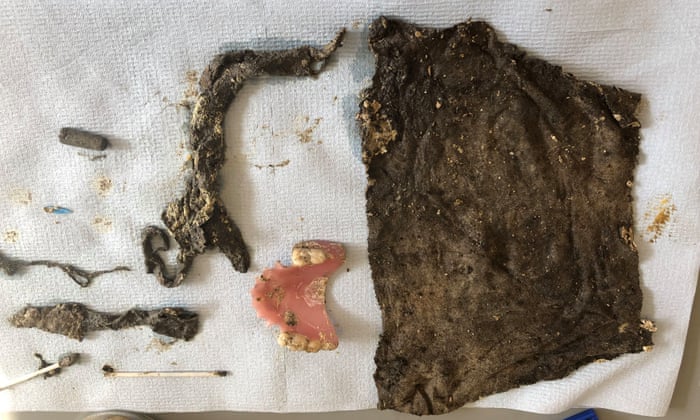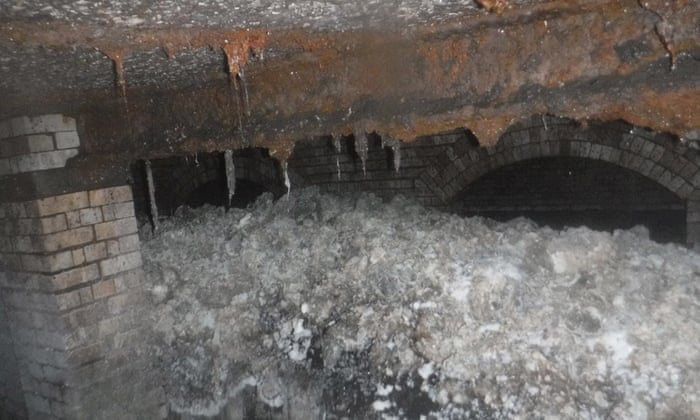Egregious Waste Habits in Toilet/Sink Flushing
"We were all rather surprised to find that this Sidmouth fatberg was simply a lump of fat aggregated with wet wipes, sanitary towels and other household products that really should be put in the [garbage] bin and not down the toilet."
"Sidmouth is a small coastal community [in southwestern England] that is largely populated by retired people, so in a sense that explains it."
"This is not a hotbed of crime and drug-taking or anything like that. The microfibres we did find probably came from toilet tissue and laundry, and the bacteria were those we would normally associate with a sewer."
"It was my first time analyzing a fatberg, and when you smell it you think this is going to be the last time because the smell was honking. It was awful to do, it smelled gross."
Dr.John Love, professor of synthetic biology, University of Exeter
 |
| Sewer worker next to the fatberg South West Water |
In 2017, the world was introduced to the notoriety of urban fatbergs, greatly immense aggregations of household waste, along with cooking grease, whose size typically blocks sanitary sewage systems and cause an ungodly odour of fermenting rot. A 140-tonne fatberg was discovered in London's East End that year, and an 'autopsy' later conducted to determine what, exactly such a gigantic slug of discarded material might possibly consist of, aside from the suspected main ingredient; fat.
What was found was that the residents of London, similar to what residents of New York City were doing, were flushing condoms down the toilet, along with syringes and narcotics -- with the inclusion of cocaine and ketamine -- and all these forbidden objects which even the village idiot should be aware, have no place in a toilet being flushed through the sewer system, were lodged within that time-accumulated fat globule of monumental size.
More recently, a routine check by South West Water, an industrial sewage maintenance company managing the Sidmouth sewers (as well as 11,000 square kilometres of sewage lines throughout England), had a routine check done on the condition of its sewers last year. This is when it was revealed that a 64-metre-long fatberg was comfortably resting under the seaside town's seafront road, the Esplanade.
Its discovery set a removal operation into motion to dismantle the lump. Workers laboured for eight weeks to excavate the resulting 36 tanker loads of debris that comprised the fatberg, at a cost of $123,000. Sidmouth, it should be noted, has a population of merely 13,000 people who live there year-round. Its modest population size would never have registered as a potential site where such a fatberg could go undetected for so long.
"We wanted to learn as much as we could about it, how it was created and what it was made of", Andrew Roantree, South West Water's director of waste water, commented. Which led to four ten-kilogram lumps being extracted from the blockage and sent over to the nearby University of Exeter for scientists there to examine, by agreement. A ten-scientist team responded to the challenge, under the leadership of Dr. Love.
They melted down parts of the mass they had been put in charge of, carrying out a dissection, extracting and identifying the waste materials, and even extending the process to perform DNA sequencing. For obvious safety reasons, the researchers equipped themselves with stab-proof gloves and steel-capped boots for protection. Weeks of analysis led them to the conclusion that no dangerous bacteria or chemicals were present in the lumps.
What was present was a composition of domestic waste all glued together by home-cooking fats, dumped down the sink drain or the toilet. The contents of the fatberg reflected the makeup of the town's population; elderly retired people. Not that age fails to confer appropriate intelligence, or being retired should equate with both cognitive and physical decline or laziness, but in this instance it appears that both perceptions might be correct.
 |
| False teeth among the things found in the fatberg. Photograph: University of Exeter/PA |
Within the massive, disgusting mess were wet wipes, oils, sanitary products, and surprise! a set of false teeth. Municipal authorities could be forgiven in assuming that most people are intelligent enough not to flush wet wipes, sanitary napkins and towels and elders' diapers or condoms of anything other than normal biological waste and toilet paper down the toilet, yet even so public education campaigns reminding people are often launched by necessity.
Sidmouth's disgustingly stomach-churning mess of a fatberg was longer than the Tower of Pisa. But great relief, right? It was found, and removed, and the event memorialized through publicity. Are the residents of Sidmouth any the wiser now? Actually, according to South West Water's director of waste water, Mr. Roantree, the sewer re-visited in the last few weeks was discovered to be hatching yet another fatberg.
Which the company plans to speedily address and remove before it takes any greater size. While they're at it, they should melt a portion of the fatberg to extract some of the odoriferous liquid to spray it over the homes whose toilets produce these messes, as a reminder to residents that this is their disgusting habit, to create these noxious substances, through indifference and neglect and outright stupidity. And through DNA analysis, identify to which of the households the dental set should be returned.
"Although we deal with around 8,500 blocked sewers every year, the Sidmouth fatberg was by far the largest discovered in our service history."
We wanted to learn as much as we could about it, how it was created and what it was made of to help us avoid further fatbergs in future."
"The results confirm our suspicions, that fat and non-flushable products such as wipes are the main culprits, and that fatbergs are a consequence of the individual and collective impact that our behaviour has on our environment."
"We will be using these results to help us educate, inform and change the behaviours of people in terms of what they are putting down the toilet and sink. That’s not just applicable to Sidmouth, but across our region."
Andrew Roantree, director of waste water, South West Water
 |
| It took eight weeks for a team to remove the fatberg from the sewer after it was discovered a year ago. Photograph: South West Water/PA |
Labels: Human Condition, Stupidity, Waste

0 Comments:
Post a Comment
<< Home